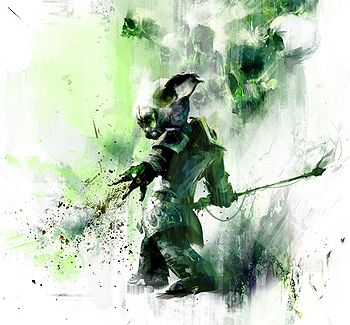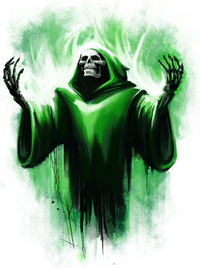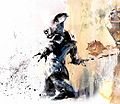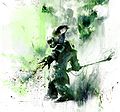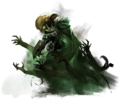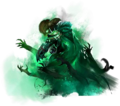Necromancer
“Practitioners of the dark arts, necromancers summon minions, wield the power of ritual, and heal themselves with blood magic. Necromancers feed on life force, which they can leverage offensively or use to delay their own demise.
Necromancer is a profession of masters of the dark arts who absorb life force from nearby deaths to fuel their profession mechanic, Death Shroud. In Death Shroud, necromancers endure incoming attacks while striking their enemies, ensuring they always outlive their foes. Necromancers command over death itself, they can summon undead minions to fight for them, overwhelm their enemies in conditions, corrupt their boons, channel blood energy, and rend their enemies' souls. As a scholar profession, necromancers wear light armor.
Necromancers who venture into the Heart of Maguuma with the Heart of Thorns expansion can choose to become ![]() reapers, utilizing the more melee-oriented Reaper's Shroud along with shouts to become powerful forces of chilling death and destruction, reaping soul and body alike.
reapers, utilizing the more melee-oriented Reaper's Shroud along with shouts to become powerful forces of chilling death and destruction, reaping soul and body alike.
Necromancers that traverse the Crystal Desert and the Kingdom of Elona with the Path of Fire expansion can choose to become ![]() scourges, wielding the desert sand itself to afflict their enemies and shield their allies with their sand shades and Desert Shroud.
scourges, wielding the desert sand itself to afflict their enemies and shield their allies with their sand shades and Desert Shroud.
Necromancers who wander the Canthan Empire of the Dragon with the End of Dragons expansion can choose to become ![]() harbingers, dark alchemists that afflict themselves to increase their power at the cost of their own health, throw elixirs to empower their allies and fire piercing corrosive shots from their Harbinger Shroud.
harbingers, dark alchemists that afflict themselves to increase their power at the cost of their own health, throw elixirs to empower their allies and fire piercing corrosive shots from their Harbinger Shroud.
Abilities[edit]
Profession mechanic[edit]
Shroud[edit]
Necromancers' profession mechanic is Death Shroud. They gather and store Life Force from nearby deaths and then use it to fuel their Death Shroud, which gives them access to a different set of skills and replaces their health with their life force.
- Death Shroud — Assume a spectral form and gain new skills, turning your life force into health.
- Primary articles: Life force, Death Shroud
Necromancers have more health than other scholars, and can not only extend that health through the use of the Death Shroud, but also steal life from their enemies, making necromancers a very sturdy profession. Necromancers are also great at inflicting debilitating or damaging conditions on enemies, removing conditions from allies, transferring conditions from themselves into enemies, and corrupting boons on enemies into conditions. They are also the most predominant users of fear, forcing their enemies to flee from them.
Skills[edit]
- Primary article: List of necromancer skills
Utility Skill types[edit]
- Corruption — Corruption skills are double-edged swords, applying conditions to both the necromancer and the target(s) when cast. Adept necromancers will then transfer their self-inflicted conditions onto their enemies, consume them for health, or even convert them into boons.
- Minion — Necromancers can summon undead minions to do their bidding and attack foes, and can command them to harm their enemies or even consume them for a quick refuel.
- Signet — Signets grant passive effects while equipped, and produce a powerful effect when activated. The passive effect is lost while the signet recharges.
- Spectral — These skills use spectral energy to improve the necromancer's resilience, or crowd control their foes, while generating substantial life force.
- Well — Skills that place long-lasting attacks on the ground to inflict negative effects on enemies, or positive effects on allies, over their duration.
- Other skill types
- Mark — Some necromancer weapon skills place marks on the ground, which explode when an enemy walks over them to produce a variety of effects for allies and/or foes.
- Skills unique to elite specializations
 Reaper: Shout — Skills that damage enemies around the reaper, becoming more powerful the more enemies they hit.
Reaper: Shout — Skills that damage enemies around the reaper, becoming more powerful the more enemies they hit. Scourge: Punishment — Skills that focus on providing boons to allies and conditions to enemies, while corrupting boons on enemies.
Scourge: Punishment — Skills that focus on providing boons to allies and conditions to enemies, while corrupting boons on enemies. Harbinger: Elixir — Skills that focus on support by providing boons and then splash dangerous effects on enemies in the area. The splash effect can be aimed on the Harbinger as well to inflict Blight and used to remove Blight to amplify their negative effects.
Harbinger: Elixir — Skills that focus on support by providing boons and then splash dangerous effects on enemies in the area. The splash effect can be aimed on the Harbinger as well to inflict Blight and used to remove Blight to amplify their negative effects.
Specializations[edit]
Necromancers have five core specializations, and three elite specializations:
Core[edit]
 Spite — Focuses on improving strike damage, might generation, and inflicting vulnerability on enemies. May enhance axe, focus, and signet skills.
Spite — Focuses on improving strike damage, might generation, and inflicting vulnerability on enemies. May enhance axe, focus, and signet skills. Curses — Focuses on inflicting conditions, improving condition damage, and benefiting from critical hits. May enhance scepter, and corruption skills.
Curses — Focuses on inflicting conditions, improving condition damage, and benefiting from critical hits. May enhance scepter, and corruption skills. Death Magic — Focuses on defense by gaining carapace, protection, and removing conditions. May enhance minions.
Death Magic — Focuses on defense by gaining carapace, protection, and removing conditions. May enhance minions. Blood Magic — Focuses on support through healing, life stealing, and reviving allies. May enhance dagger, and warhorn skills.
Blood Magic — Focuses on support through healing, life stealing, and reviving allies. May enhance dagger, and warhorn skills. Soul Reaping — Focuses on improving Shroud and life force generation. May enhance marks from staff skills.
Soul Reaping — Focuses on improving Shroud and life force generation. May enhance marks from staff skills.
Elite[edit]
 Reaper — Focuses on chill application and melee combat. Grants access to greatsword, shout skills, and replaces Death Shroud with the more aggressive Reaper's Shroud.
Reaper — Focuses on chill application and melee combat. Grants access to greatsword, shout skills, and replaces Death Shroud with the more aggressive Reaper's Shroud. Scourge — Focuses on granting barriers, condition damage, and corrupting boons. Grants access to torch, punishment skills to convert boons into torment, and replaces Death Shroud with Sand Shades and shade skills, most notoriously Desert Shroud.
Scourge — Focuses on granting barriers, condition damage, and corrupting boons. Grants access to torch, punishment skills to convert boons into torment, and replaces Death Shroud with Sand Shades and shade skills, most notoriously Desert Shroud. Harbinger — Versatile specialization, possessing powerful potential, at the cost of their own life due to Blight. Gives access to a mainhand pistol, elixirs for boons, and replaces Death Shroud with the more offensive Harbinger Shroud.
Harbinger — Versatile specialization, possessing powerful potential, at the cost of their own life due to Blight. Gives access to a mainhand pistol, elixirs for boons, and replaces Death Shroud with the more offensive Harbinger Shroud.
Traits[edit]
See list of necromancer traits.
Equipment[edit]
Armor[edit]
The necromancer is a scholar profession and wears light armor.
Weapons[edit]
See also detailed list of necromancer weapon skills.
- Two-handed
- Greatsword — Slow attacks with massive damage, focusing in close combat and chill. (Reaper specialization or Weaponmaster Training)
- Staff — Long range spellcasting weapon which emphasizes AoE support via use of marks.
- Spear — Melee weapon that focuses around collecting Soul Shards and spending them with Perforate. (Janthir Wilds)
- Main-hand
- Axe — Use powerful attacks to tear enemies at medium range.
- Dagger — Steal an enemy's health or life force at close range.
- Scepter — Inflict various conditions on foes at a long range.
- Pistol — Torments, poisons, and weakens your enemies at range. (Harbinger specialization or Weaponmaster Training)
- Sword — Mobile mid-range weapon that heals the wielder and is capable of becoming stronger at the cost of the wielders health. (Expanded Weapon Proficiency)
- Off-hand
- Dagger — Weaken foes or transfer conditions to them.
- Focus — Make the enemy vulnerable or chill them, while removing boons.
- Warhorn — Summon a swarm of locusts or fear enemies with the wail of the horn.
- Torch — Torment and burn your enemies while empowering your allies. (Scourge specialization or Weaponmaster Training)
- Sword — Controlling mid-range weapon that heals the wielder, saps strength from enemies and strikes fear in their hearts, for a price of blood. (Expanded Weapon Proficiency)
- Aquatic
- Spear — Reap enemies with close range attacks or terrorize them by summoning vampiric shrimp.
- Trident — Thwart the enemy with offensive support and sink them into the abyss.
There are ten possible weapon sets for this profession and two weapon sets while underwater. The necromancer can equip and alternate between two weapon sets during combat.
Crafting[edit]
The following crafting disciplines can create items that are useful to the necromancer:
- Weaponsmith — Axes, daggers, greatsword, spears.
- Huntsman — Torches, warhorns, pistols.
- Artificer — Focus, scepters, staves, tridents.
- Tailor — Light armor.
- Jeweler — Jewelry.
- Chef — Food.
Personal story[edit]
In the biography step of character creation, necromancers must decide what they would mark their face with. This choice is merely cosmetic and determines their starting head armor, which can be hidden or transmuted after character creation.
| A necromancer's closest companion is death. In acknowledgement of this, I mark my face with the symbol of a _____. | |
|---|---|

|
Trickster Demon ("trickster demon") — Trickster demons from the Mists find ways to enter our world to tear it apart. I, too, am a destructive force, and all shall fear me. |

|
Skull ("skull") — I respect the traditions of necromancers that have gone before me. I mark my face with the symbol of a skull to remind me that even the greatest die eventually. |

|
Ghostly Wraith ("ghostly wraith") — A wraith is a creature of energy, and its cunning helps it elude its enemies. What you cannot see...can kill you. |
Lore[edit]
Amongst human necromancers, Grenth is often worshipped as their patron god. While norn necromancers often revere Raven over the other Spirits of the Wild.
- Notable necromancers
- See also: Category:Necromancer NPCs
- Havroun Weibe
- Jhavi Jorasdottir
- Livia
- Marjory Delaqua
- Palawa Joko
- Desmina
- Queen Nahlah
- Trahearne
- Ankka
Gallery[edit]
- Concept art
- Pre-launch promotional screenshots
- Icons
Trivia[edit]
| The Guild Wars Wiki has an article on Necromancer. |
- The necromancer was previewed under this image until its unveiling on the 25th August 2010.
- The necromancer was first revealed at the Gamescom 2010 demo, and was unveiled on the official website on Wednesday, August 25.
- The unique mechanic of the necromancer was originally based around collecting souls from enemies and using them to summon minions.
- Necromancer specializations are named after the Necromancer attributes from the original Guild Wars.
External links[edit]
- Necromancer on the official website.
